At a time when the global population continues to grow, arable land is increasingly scarce, and natural resources are strained to the breaking point, producing and utilizing food efficiently is more important than ever. And yet, each year an estimated one third of all food produced ends up rotting in the bins of consumers, restaurants, and retailers, or spoiling due to poor transportation and harvesting practices.
Food waste isn’t just a pity; it also contributes to global food insecurity. Today, 811 million people worldwide don’t know where they will get their next meal. Furthermore, food waste contributes to a whopping 10% of global greenhouse gas emissions. If wasted food were a country, it would be the world’s third largest emitter of greenhouse gases after the US and China!
To raise awareness of this problem and support potential solutions, this year September 29th has been designated the International Day of Awareness of Food Loss and Waste (IDAFLW) by the United Nations General Assembly. Marking this day also supports Sustainable Development Goal 12.3, which aims to reduce food waste at the retail and consumer level by 50% by 2030.
Reducing food loss and waste is key to ending global hunger and fighting climate change. At Avery Dennison, we are developing new technologies and collaborating with external partners to contribute to the solution.
Main causes of food loss and waste
To start, a couple of definitions: “food loss” refers to food products which go uneaten during the production and distribution stage. “Food waste,” on the other hand, refers to food that is ready and available to be eaten, but instead gets discarded or expires. Globally, around 14% of food is lost from production through distribution, while 17% is wasted after distribution (11% in households, 5% in food service, and 2% in retail).
Food loss and waste occur for a variety of reasons. These include:
Spoilage after harvesting caused by poor storage conditions or supply chain irregularities
Rejection and subsequent disposal for aesthetic reasons (e.g. atypical shape, dented packaging)
Spoilage at restaurants, supermarkets, and at home due to overbuying
Stringent food safety regulations that force retailers to remove edible food from shelves too soon
Misunderstanding of the meaning of “use by” vs “best by” vs “ expiration” dates
Clearly, this is a complex problem!
Reducing waste through smart packaging and labels
While there are many opportunities for food to be lost or wasted, there are also many opportunities for improvement. At Avery Dennison, we are focused on finding ways for innovative, high performing labels to help reduce waste.
For example, we offer label materials which can help extend the shelf life of food, such as our PVDC-free reclosure labels. These prolong the lifespan of packaged foods ranging from fresh herbs to lunch meats by minimizing exposure to oxygen (which causes discoloration and encourages bacteria growth that leads to rancidity). At the same time, they enable recycling, since they’re free of PVDC (a common contaminant in the recycling stream), and thereby help reduce the amount of plastic packaging that ends up in landfills.


